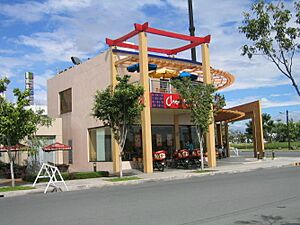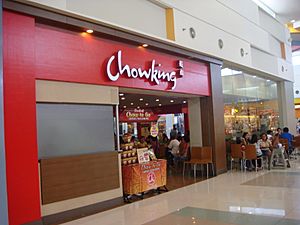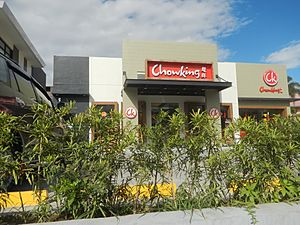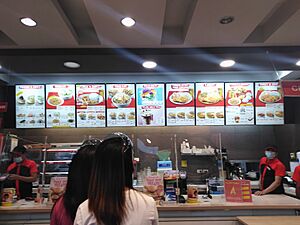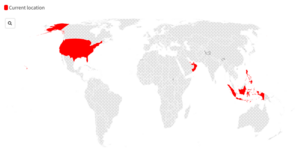Chowking facts for kids
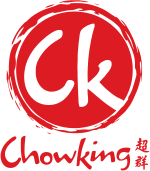 |
|
| Owner | Fresh N' Famous Foods (Jollibee Group) |
|---|---|
| Introduced | March 18, 1985 |
| Related brands |
|
| Previous owners | Chowking Food Corporation |
| Website | |
Chowking (超群, pronounced chāoqún) is a popular fast food restaurant chain from the Philippines. It serves delicious Filipino Chinese food.
Chowking started in 1985. It became part of the Jollibee Group in 2000. Many people think it's the most popular place for Chinese-Filipino food. It was even the second-largest fast food chain in the Philippines at one point. Today, there are more than 600 Chowking restaurants around the world!
Contents
The Story of Chowking
How It All Began (1985-1999)
Robert Kuan came from a Chinese-Filipino family. He earned a special business degree in 1975. Later, he became the boss of Ling Nam, a Chinese restaurant in Manila. He helped it grow into a small chain of restaurants.
However, there were family problems at Ling Nam. Kuan learned that other owners wanted him to leave. His friend Henry Sy advised him to start his own Chinese restaurant. Kuan wanted to create a fast food place. This would be different from popular Western-style fast food chains like Jollibee and McDonald's.
Chowking Food Corporation officially started on February 19, 1985. The main investors were Robert Kuan, Jollibee founder Tony Tan Caktiong, and Wilson Chu. After two years, Kuan and Caktiong bought Chu's shares. This meant they each owned half of the company.
The very first Chowking opened on March 18, 1985. It was located in Makati, a city in the Philippines. In 1989, Chowking began offering franchises. This helped them open new restaurants in more places. The first franchise opened in Meycauayan, Bulacan. By that year, Chowking had ten locations.
In 1992, Chowking expanded outside of Luzon, the main island. They opened stores in Cagayan de Oro in Mindanao and Bacolod in Visayas. A report from the U.S. government thought Chowking would do well. This was because Filipinos loved Chinese food. They also liked the clean, bright, and quick service Chowking offered. By the end of 1992, there were 21 Chowking restaurants. In 1996, Chowking opened its 100th location.
A book about fast food in the Philippines (2017) found something interesting. Chowking's biggest rivals were not other fast food chains. Instead, they were local, family-owned Chinese restaurants. When Chowking opened in San Fernando, Pampanga, in 1997, many local restaurants changed their menus. For example, they started adding sugar to their siopao to make it taste more like Chowking's.
In late 1999, Robert Kuan agreed to sell his share of Chowking to Tony Tan Caktiong. Caktiong was the chairman of the Jollibee Group. At that time, Chowking had 162 branches. This included four in the United States and three in Dubai. The Wall Street Journal called it the most successful Chinese food chain in the Philippines. Kuan said he sold Chowking because it was a good offer.
In the 1990s, Chowking also had its own basketball team. It was called Chowking Fastfood Kings. The team helped coach Leo Austria become well-known in 1998. After Jollibee bought Chowking, the team was sold to another company.
Joining Jollibee (2000-Present)
Jollibee officially bought Chowking Food Corporation in March 2000. A Jollibee vice president, Rufino L. dela Rosa, said this would help Chowking save money. They could cut costs for supplies, marketing, and office work. It would also make storage space more efficient. This was especially true if new Chowking restaurants were built next to Jollibee ones.
Rufino dela Rosa had worked as Jollibee's chief financial officer for twelve years. He was the one who successfully worked out the deal with Robert Kuan. Tony Tan Caktiong then offered dela Rosa the job of Chowking's new CEO and president. Dela Rosa accepted the offer. In 2000, Chowking's earnings grew to ₱2.4 billion. This was up from ₱2.08 billion in 1999.
To make its business structure simpler, Jollibee combined Chowking with other companies in 2006. These included Greenwich Pizza and Baker Fresh Foods Philippines. The new combined company was named Fresh N' Famous Foods Inc. By then, Chowking had 342 stores in the Philippines.
From 2006 to 2008, Chowking spent ₱270 million to make its operations more modern. They improved their Noodle Building. They also added more machines to their food production lines. These lines were in their two main food preparation centers, called commissaries. These centers are in Muntinlupa. They also serve as warehouses and places to send out food.
In August 2010, Chowking got a new look and a new slogan. The slogan was "Tikman ang Tagumpay," which means "Taste Success."
Chowking Around the World
In 1996, Chowking opened its first restaurant outside the Philippines. It was in San Diego, California, in the United States. Both Robert Kuan and Tony Tan Caktiong had plans to expand to Europe and China later on.
Three years later, Chowking entered the Indonesian market. They opened two stores in Jakarta, the capital city.
In 2004, Chowking opened its first two stores in Dubai, United Arab Emirates. By 2008, Chowking had over 400 stores. These were located in the Philippines, Indonesia, the United States, and the Middle East. In Dubai, Chowking's main food preparation center supplied ten stores.
In 2011, Jollibee took control of Chowking's franchised operations in the USA. They later gained full ownership.
Chowking has also grown in the Middle East. In February 2014, Chowking had 19 stores in the UAE. They also had five in Qatar and two in Oman. The first Chowking in the UAE opened in April 2003. The restaurants in the UAE are much larger. They mostly serve Filipinos living abroad. Because of this, Chowking UAE added more "Filipino home-style dishes" to its menu. These include bulalo (beef soup) and kare-kare (peanut stew).
What's on the Menu?
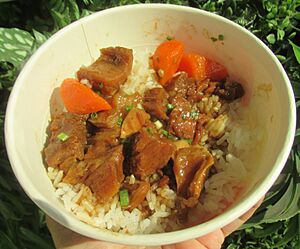
Chowking offers Filipino Chinese cuisine. This is different from what you might find at typical fast food places. Chowking sells dishes that you can't buy at bigger chains like McDonald's or Jollibee.
Its menu has many different choices. You can find chicken and beef dishes served with rice. There are also Filipino dishes like mami (noodle soup) and sweet-tasting siopao (steamed buns). For dessert, they have the Filipino halo-halo. This is a popular cold dessert with mixed ingredients. It is one of Chowking's most popular items.


